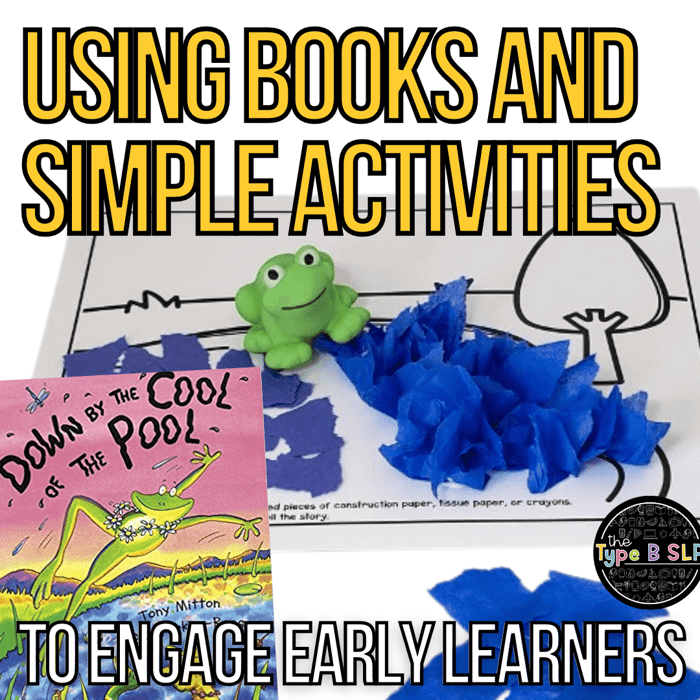
Using Books and Simple Activities to Engage Early Learners: Guest Post
Using Books and Simple Activities to Engage Early Learners
Hi! My name is Stacey Richey, and I have been an SLP for almost 10 years. I have worked in public schools (PK-6th grades) with a caseload size ranging from 60-100 students, so I know how hard it is to see all of your students effectively without having a ton of time to prep! I LOVE using books in therapy because I can target so many different areas in one lesson! I have a HUGE collection of books (just ask my husband ;)).

Down by the Cool of the Pool by Tony Mitton is one of my favorite books for Preschool-1st grade. It reinforces through repetition, but is also highly engaging. The book is easily adaptable for mild to severe delays. I created a lesson plan freebie (grab it at the bottom of this blog post!) that includes additional therapy ideas, specific speech targets, and common core standards.
Here’s a brief list of some of the areas you can target with this book (check out my freebie for specific targets):
- Articulation
- Phonological processes/patterns
- Apraxia (CV and CVC words)
- Language [verbs, pronouns (I/me/you), negation (not)]
- Phonological awareness (rhyming, short/long vowels)

This story is incredibly easy to make engaging and incorporate gross motor actions! Incorporating gross motor movements into your story will not only make the activity more intriguing, but it helps students generalize the vocabulary into other contexts. In the story, each animal dances in its own way and has a different verb/action that repeats on each page. While reading the story, imitate the animals and encourage students to do the same. Here are the actions I use:
- Frog – “whee” – put both hands in the air like riding a roller coaster
- Duck – flap – flap both arms
- Pig – wiggle – wiggle side to side
- Sheep – stamp – stomp your foot
After reading the book, I do a quick story retell with my students. You can flip back through the pictures of the book, or use objects/pictures/puppets of the animals for a more formal story retell. If students have trouble remembering the story elements, you can point to the pictures or use your action “visual” (e.g., flap arms) to prompt for support.
Next, try to incorporate another gross and/or fine motor activity while still focusing on your speech-specific targets. Since we did gross motor movements during the story, I usually choose a fine motor or sensory activity next so that I target both areas. I have listed a few simple activities below. I only pick 1-2 of these activities depending on time and the abilities of the students in the group. You could also save and repeat some of these activities for a follow-up extension lesson.
 (Left - Construction Paper) (Right - Tissue Paper)
(Left - Construction Paper) (Right - Tissue Paper)
Activity #1:
Print an outline (i.e., coloring page) of a pond or draw one on a piece of paper for each student (a thicker paper like cardstock or construction paper works best with liquid glue). Have students rip pieces of blue construction paper and glue them onto the pond. You could also use small pieces of tissue paper or dot markers. Use plastic figurines or draw animals from the book to retell the story.

Activity #2:
Make a sensory bin. Your sensory bin doesn’t have to match mine! (This is what I had lying around my house.)
1) Filler – I used black beans
2) Container – Blue bowl to be the “water”
3) Plastic animals or pictures to find in the sensory bin
4) I added a few plastic leaves (which are definitely optional)
If you don’t have these materials to make a sensory bin, print off pictures of the animals from the story and hide them around the room. Act out the animal you find (e.g., frog – ribbit and hop like a frog). See if you can put them in the same order as the story. Use the pictures from the book for support.

Activity #3: *Note: Check for food allergies before doing this activity*
Materials : unfrosted cupcakes or sugar cookies, frosting, green food coloring, plastic knives/spoons, large marshmallows, raisins/chocolate chips/chocolate candies, thin licorice
Have a “cooking” activity. Using unfrosted cupcakes or sugar cookies, complete the following steps:
1) Make green frosting using white frosting, green food coloring, and plastic knives/spoons (or buy pre-colored frosting).
2) Spread some frosting over your cupcake/cookie.
3) Cut the large marshmallow in half cross wise (i.e., cut along the longest side to make two short round pieces).
4) Place both marshmallow halves sticky side up in the frosting.
5) Place a pupil in the middle of each marshmallow half (i.e., raisin, chocolate chips, or chocolate candies).
6) Cut the thin piece of licorice into a small mouth.
7) Place mouth on the frog.
8) Enjoy!
3 Important Things to Remember:
1. You don’t need a lot of fancy materials to make a lesson engaging and fun.
2. Incorporating activities across different modalities (e.g., gross motor, fine motor, etc.) will help students generalize therapy targets more quickly.
3. Try to use one book to target multiple areas so you have less to plan/prep!
Be sure to grab my lesson plan freebie that contains additional therapy ideas and targets!
Come say hi to me on Instagram.
Follow me on Pinterest to find even more therapy ideas.
I hope you love this book as much as I do!
Thanks for having me!
Stacey Richey, SLP

